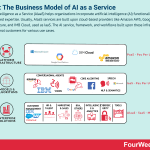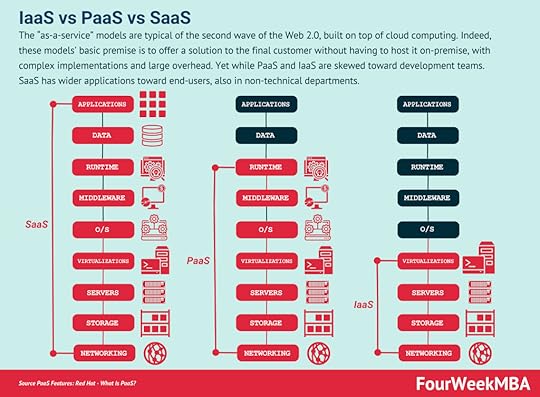AIaaS: The New Business Model of Artificial Intelligence as a Service

Artificial Intelligence as a Service (AlaaS) helps organizations incorporate artificial intelligence (AI) functionality without the associated expertise. Usually, AIaaS services are built upon cloud-based providers like Amazon AWS, Google Cloud, Microsoft Azure, and IMB Cloud, used as IaaS. The AI service, framework, and workflows built upon these infrastructures are offered to final customers for various use cases (e.g., inventory management services, manufacturing optmizations, text generation).
Understanding Artificial Intelligence as a ServiceArtificial Intelligence as a Service allows businesses to experiment with artificial intelligence in a low risk environment and without a significant upfront investment.
AlaaS is a more recent addition to a suite of “as a service” products that help businesses maintain a focus on their core operations. It is becoming increasingly popular, with the International Data Corporation predicting that 75% of commercial enterprise applications will use AI in the coming years. As a result, large organizations such as Amazon, Google, IBM, and Microsoft all now offer AlaaS to customers.
To understand this industry, it’s important to understand its various layers. Just like SaaS, built on top of IaaS, PaaS, also AIaaS, is built on top of cloud infrastructure that works as the basis for the service itself.
 The “as-a-service” models are typical of the second wave of Web 2.0, built on top of cloud computing. Indeed, these models’ basic premise is to offer a solution to the final customer without having to host it on-premise, with complex implementations and large overhead. Yet while PaaS and IaaS are skewed toward development teams. SaaS has wider applications toward end-users, also in non-technical departments. The various types of AlaaS
The “as-a-service” models are typical of the second wave of Web 2.0, built on top of cloud computing. Indeed, these models’ basic premise is to offer a solution to the final customer without having to host it on-premise, with complex implementations and large overhead. Yet while PaaS and IaaS are skewed toward development teams. SaaS has wider applications toward end-users, also in non-technical departments. The various types of AlaaSAlaaS is a relatively broad term that can be divided into distinct types:
Cognitive computing APIs – where an application programming interface (API) developer can utilise API calls to incorporate artificial intelligence into applications. This encompasses a range of services including computer vision, knowledge mapping, and natural language processing (NLP). Each has the ability to generate business value from unstructured information.Bots and digital assistance – a very popular form of AlaaS including automated email services, chatbots, and digital customer service agents.Fully-managed machine learning services – ideally suited to non-technological organizations who desire a fully managed approach. These services invariably offer customer templates and pre-built models. For the most technologically-challenged, they also offer code-free interfaces.Machine learning frameworks – or frameworks that allow organizations to build custom models that will only handle a small amount of data.Advantages of Artificial Intelligence as a ServiceIn an increasingly automated digital world, there are a multitude of benefits to AlaaS.
Here are just a few of them:
Reduced cost. AlaaS helps small and medium-sized companies, in particular, become more profitable by minimizing outlay. Profitability increases as companies are able to avoid hiring programmers or investing in expensive machinery. Put differently, they don’t need to build, test, and implement artificial intelligence systems from scratch. Ease of use. The vast majority of AlaaS companies offer packaged products that don’t require expertise to implement. Having said that, developers from the business using AlaaS can easily tweak the product if desired.Scalability and flexibility. Some businesses will be uncertain as to whether Artificial Intelligence as a Service is right for them. This uncertainty can be alleviated by starting small and then scaling later as knowledge and confidence increase or corporate requirements change. To help facilitate the onboarding of AlaaS, many providers offer their services at a fixed rate. This increases flexibility because customers are free to pay for what they use, and no more. Ecosystem growth and integration. The most robust systems are fully integrated, but integration is hindered when artificial intelligence can only be used in a small subset of business operations. Companies such as NVIDIA and Siemens have partnered with AlaaS vendors to overcome incompatible technologies – thereby allowing product teams to increase integration, speed, and efficiency.How Does AIaaS get monetized?As the world itself explains, AIaaS gets monetized in the form of subscription/retainer that comprises the management, running and monitoring of the AI/ML Models that are used as the foundation fo the provided service.
Imagine the specific case of a company providing AI models for improving manufacturing processes. The AIaaS company will work on cleaning the data from the customer, plugging that into its AI models to generate reports, monitoring, and workflows for process optimization.
Imagine also the case of a company providing NLG (natural language generation or automatic text generations using the latest language models), which will be running, and operating those models while the customer gets as output generated pages or workflows, paid in the form of retainer.
Part of AI services will also require maintenance, or new experimental projects can be undertaken. In these cases, those can be part of the retainer or charged separately on a pay per consumption basis as MLOps.
 Machine Learning Ops (MLOps) describes a suite of best practices that successfully help a business run artificial intelligence. It consists of the skills, workflows, and processes to create, run, and maintain machine learning models to help various operational processes within organizations. Key takeawaysArtificial Intelligence as a Service allows businesses to incorporate AI functionality without the requisite knowledge or experience.Artificial Intelligence as a Service can be divided into four distinct categories: cognitive computing APIs, bots and digital assistance, machine learning frameworks, and fully managed machine learning services.Artificial Intelligence as a Service offers a number of benefits to customers. AlaaS is a flexible and scalable service that reduces operating costs and is relatively simple to use. As more organizations work toward full integration, the service itself will become more efficient.
Machine Learning Ops (MLOps) describes a suite of best practices that successfully help a business run artificial intelligence. It consists of the skills, workflows, and processes to create, run, and maintain machine learning models to help various operational processes within organizations. Key takeawaysArtificial Intelligence as a Service allows businesses to incorporate AI functionality without the requisite knowledge or experience.Artificial Intelligence as a Service can be divided into four distinct categories: cognitive computing APIs, bots and digital assistance, machine learning frameworks, and fully managed machine learning services.Artificial Intelligence as a Service offers a number of benefits to customers. AlaaS is a flexible and scalable service that reduces operating costs and is relatively simple to use. As more organizations work toward full integration, the service itself will become more efficient.Read: MLOps, AI Industry, Blockchain Economics, Cloud Business Models, C3.ai Business Model, Snowflake Business Model.
Main Free Guides:
Business ModelsBusiness StrategyMarketing StrategyBusiness Model InnovationPlatform Business ModelsNetwork Effects In A NutshellDigital Business ModelsThe post AIaaS: The New Business Model of Artificial Intelligence as a Service appeared first on FourWeekMBA.



